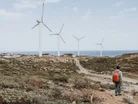How a Coal Terminal is Transforming into a Renewable Hub

A remarkable transformation is underway at the 350-acre site of a derelict coal power plant in Hunterston, Scotland.
The site is being redesigned to support offshore wind and solar connection, aiding the UK’s journey towards a robust renewable energy supply chain infrastructure.
Essentially, the future energy facility utilises Liquid Air Energy Storage (LAES), a technology enabling the storage and discharge of energy, surpassing current battery capabilities.
Highview Power (HVP) spearheads the creation of the world’s most extensive LAES facility at Hunterston, a former coal terminal.
Revitalising Hunterston
Hunterston is poised to become a central player in the UK’s pivot to renewable energy.
The upcoming LAES facility there will have the capacity to power 650,000 homes for nearly 13 hours.
Besides bolstering the local and national economy through the creation of 1,000 jobs, Hunterston is expected to draw £3.5bn (US$4.4bn) in investments, promising more than 5,000 future job opportunities in the renewable sector.
Notably, XLCC, a high voltage direct current cable (HVDC) manufacturer, received a £9m (US $11.4m) grant from Scottish Enterprise for its £1.4bn (US$1.8bn) cable manufacturing facility at Hunterston.
XLCC's first UK undersea energy cable factory, which connects with solar farms in North Africa, is already 90% under option, meaning a buyer the exclusive right to purchase it within a set time frame with no obligation to purchase.
These HVDC cables are vital for long-distance electric power transmission, particularly between power grids and through undersea routes.
The cables are increasingly critical as nations seek to enhance energy security by diversifying into renewable resources, with the efficient transmission features of HVDC cables are essential for this strategic connectivity.
Peel Ports’ vision
Peel Ports, which operates many terminals including one at Hunterston through Clydeport, plans a substantial investment of up to £150m (US$190m) to transform Hunterston into an advanced renewable energy hub, focusing on offshore wind.
The company intends for Hunterston to be at the forefront of the UK’s net-zero future.
James McSporran, Port Director of Peel Ports Clydeport explains: “The idea that the UK lacks the necessary infrastructure for a just transition is simply a myth.
“Scotland particularly already has the reputation, infrastructure and talent to support renewables projects, meet national environmental aspirations, create long-term green jobs and unlock local and national economic growth opportunities.
“In the meantime, we are working hard to bring our aspirations to life. We currently estimate the consenting process for the Hunterston redevelopment will be complete by early 2025, followed by two years of construction.”
Highview Power’s strategic focus
HVP is dedicated to revolutionising the renewable energy sector, particularly through its advancements in LAES technology.
The organisation has committed to several concrete goals:
- Flexible demand: When the supply of renewable energy outstrips demand excess output is captured, relieving pressure on the grid, cutting wastage and reducing the need for costly and inefficient curtailment programmes
- Long duration storage (LDS): The storage solution uses the power of air to stockpile and reserve renewable energy until it’s needed
- Responsive generation: When demand exceeds supply, 100% clean energy is re-generated, solidifying the shift from fossil fuels to wind and solar
- Strengthened stability: Demand for stability services is set to grow significantly because of the retirement of gas generation, the company provides cost-effective grid stabilisation, reduced reliance on fossil fuels, energy security and cheaper and more stable energy costs.
The full potential of sites like Hunterston is crucial for the UK to achieve its net-zero targets and secure a stable energy transition, bringing broad socioeconomic benefits.
Explore the latest edition of Energy Digital Magazine and be part of the conversation at our global conference series, Sustainability LIVE.
Discover all our upcoming events and secure your tickets today.
Energy Digital is a BizClik brand




